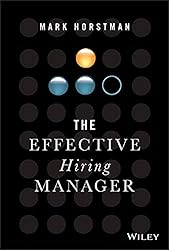
Rating: 7.2/10.
Book on hiring, from screening resumes, interviews, and offer. It mostly focuses mostly on on behavioral interviews, which are the only type that is applicable to any job, so I’m a bit disappointed because it doesn’t offer any specific details on other types of interviews or data to back up its claims, especially for some surprising suggestions, like saying everyone in a full-day interview should ask the candidate the same questions. I would’ve liked to see more about various types of non-behavioral questions, including technical ones and take-home exercises.
Hiring is an important skill for managers, but many don’t get to do it often so they lack practice. When an employee leaves, you should think about whether it’s really necessary to hire a replacement, given how expensive hiring can be. The first golden rule in recruiting is to set the bar high; missing out on a good hire is a minor setback compared to the headache of managing a bad fit.
Focus the hiring process on behavioral interviews; work with your team to figure out the behaviors you want in the new hire and then ask questions that make candidates prove they’ve shown these behaviors in the past. The first step is screening resumes; be cautious about job titles as they can vary across organizations. Look for growth and accomplishments rather than just responsibilities, since someone could have had lots of responsibilities but got fired for not meeting them. Know the competitiveness of different schools, even those in foreign countries like India. Watch for red flags like multiple short jobs or attempts to hide info like omitting job months. Also, check their social media for any content that might be a problem.
After resume screening, do a 30-minute phone screen; you could have HR start it, but since they might not know exactly what you want, you should also make your own calls. For onsite interviews, send candidates a plan for the day in advance. Schedule 1-1 interviews with different team members and include a team lunch, which gives you a chance to see how candidates behave informally. Never do panel interviews; go 1-1 and gather everyone’s feedback later. Each interviewer should ask the exact same set of questions to the candidate (so the candidate will give the same answer multiple times in one day). Start with small talk and a “tell me about yourself” question, then dig into behavioral questions. Probe into why candidates made certain decisions and check for good communication skills. Finally, leave some time for them to ask you questions; their questions aren’t as crucial as yours, but be wary if they ask bad or selfish questions, like those about compensation.
After all the interviewers have written their notes, they should make a “hire” or “no-hire” decision independently. Then, have a meeting to talk about the candidate and only make the offer if everyone agrees to hire; some exceptions may apply if the interviewer is junior. After that, check references; start by asking factual questions like confirming titles and work dates, then dig deeper into specifics like how they managed projects, and look for any weaknesses that could be a dealbreaker.
When giving offers or rejections, it’s good to move quickly, ideally on the same day you make the decision. It’s better to call, but leaving a voicemail is fine too; aim to stay in touch at least every three days. Even if you’re comparing multiple candidates and are not sure who to offer the job to first, don’t keep the other candidates waiting. Once you’ve made the offer, the ball is in their court; have a checklist of steps for both you and them to follow, covering everything from HR paperwork to actually getting started on the job.



